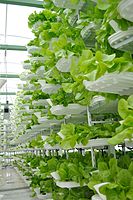
Photo from wikipedia
Fine particulate matter (PM2.5) has become a significant issue of ecological environment. However, few studies have explored the vertical distribution of PM2.5 in cities. The objectives of this paper are… Click to show full abstract
Fine particulate matter (PM2.5) has become a significant issue of ecological environment. However, few studies have explored the vertical distribution of PM2.5 in cities. The objectives of this paper are to reveal the vertical distribution regular pattern of PM2.5 over urban underlying surfaces near the ground with a hexacopter-type unmanned aerial vehicle (UAV) in winter. Results showed that the maximum vertical gradient of PM2.5 near the ground was typically the greatest in the morning as the stable atmospheric conditions. Moreover, regression model illustrated that relative humidity had the greatest impact on the vertical profile of PM2.5 compared to air temperature and altitude as hygroscopic of PM2.5 aerosols. Curve model shown that vertical profile of PM2.5 over the surfaces of water and green space first increased slowly and then declined, besides, the highest concentration inflection of PM2.5 above the water body (23.7 m) is higher than the green space (14.3 m). Thus, suggesting residents living vertical of 10–30 m from the ground around large water bodies and green spaces should not open windows for ventilation in the morning. Therefore, this study provides insights into the vertical distributions of PM2.5 over different underlying surfaces and should be of reference value to urban planners for designing urban spaces to optimize atmosphere environment to provide a healthy living environment.
Journal Title: Environmental Monitoring and Assessment
Year Published: 2021
Link to full text (if available)
Share on Social Media: Sign Up to like & get
recommendations!